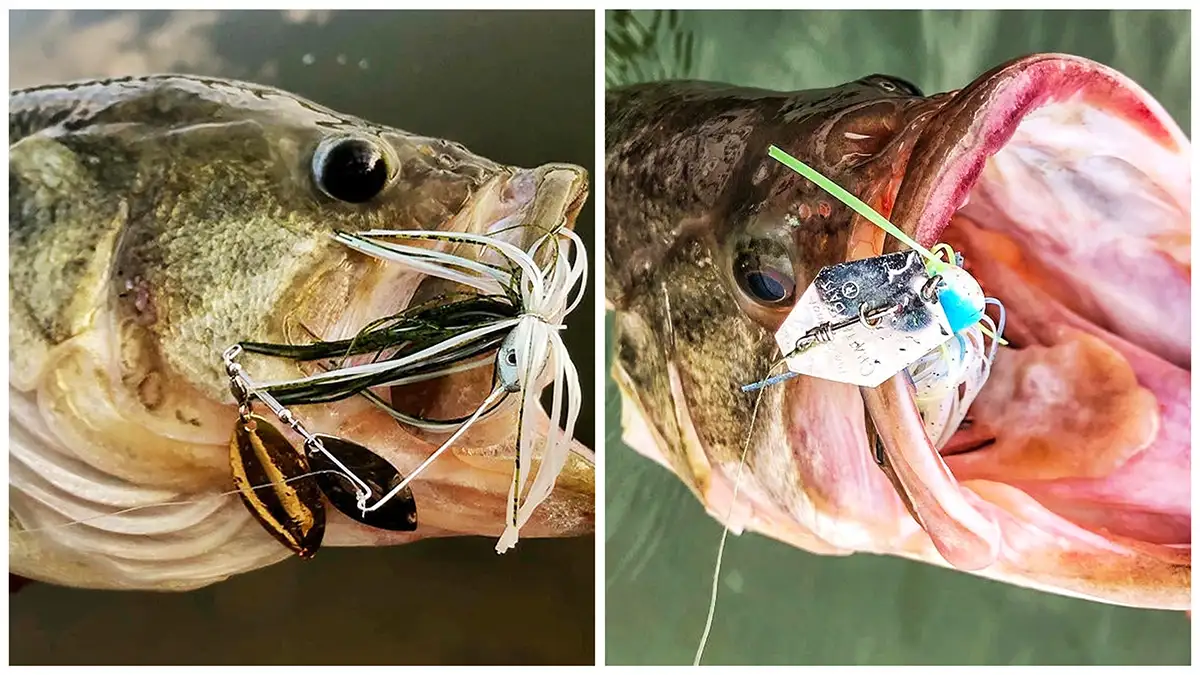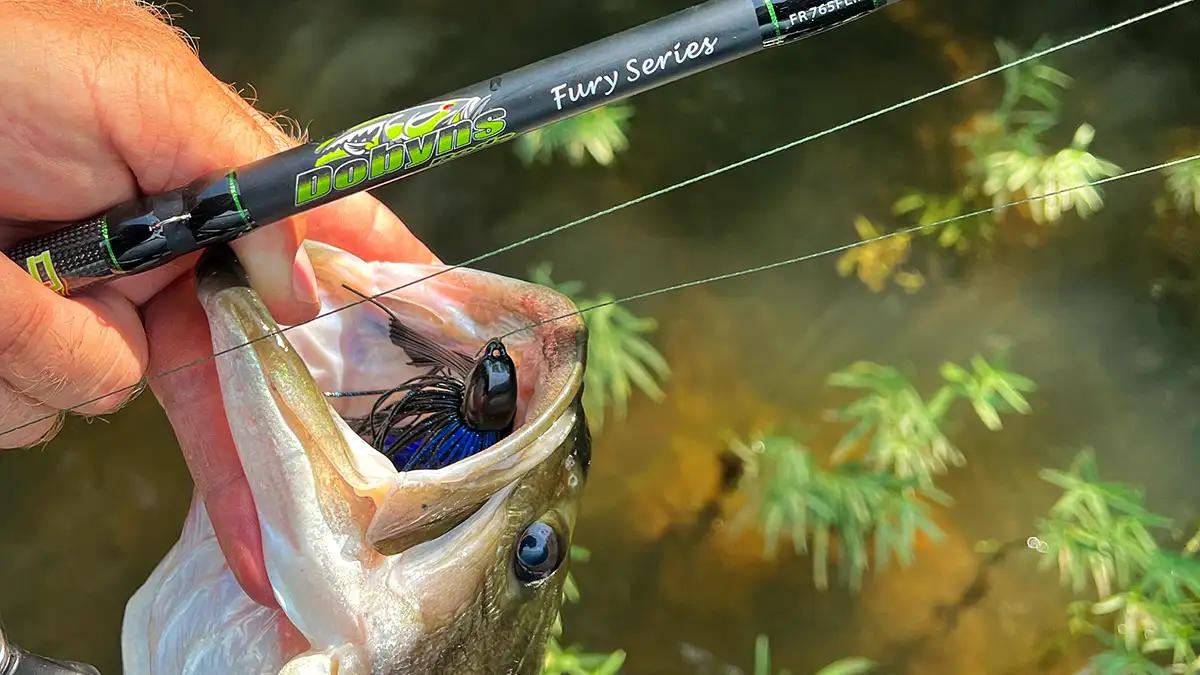Whether you’re rolling up on a mat the size of a swimming pool or one that covers a mile-long river ledge, you’re going to have a choice to make: Do I flip it, frog it or fish the edge? The decision-making process can be a little tricky though, since the answer to all three questions is ‘yes’ in certain situations. Sometimes it’s even yes to all of the above.
There are few things as intimidating to an angler as a half-mile stretch of topped out hydrilla. But too much of a good thing can still be a good thing — if you know how to break it down. These monster mats always have a few little hotspots of activity where you can locate wads of fish.
Figuring out the right presentation or even the right rotation of baits is key though. These same principals can be applied to smaller mats as well. So let’s look at how to decide when to flip, frog or fish the edge of a mat.
DO IT ALL
The default approach I have to fishing a mat is to do all three. I start by fishing the edge first though, then frog the topped-out portion and finally move in close to pitch and punch the thicker clumps. In doing this, I’m giving myself an opportunity to dissect the whole mat in an order that will often allow me to catch fish in multiple ways.
It’s always best to start with the edges until you get a feel for how the fish are setting up. Spinnerbaits, swim jigs, vibrating jigs, buzzbaits and buzz toads are all great baits for fishing along the edge. These are great whether it’s a hard edge like you’d find along a hyacinth mat or more of a tapered edge, the way submerged hydrilla often follows the contour of a ledge as it drops off into deeper water.
Best case scenario, you pick up a few fish before moving in closer. Worst case scenario, fish blow out from under the mat and don’t get the bait. Either way you have a clue to work off of.
If you’re catching them, keep fishing the edge. If the fish are just rolling on your baits and running back to the cover, move in closer and try flipping or pitching a jig tight to the vegetation. Eventually, you’ll end up punching a bait into the mat itself or frogging over top of it if the mat sets up well for that—we’ll talk more about what that looks like in a moment.
LOOK FOR SNACKS
Locating the bait is probably the easiest way to quickly determine the best approach to a mat. If you see shad or other baitfish flicking along the edge, there’s a good chance the fish are out more in the open and using the edge of the vegetation to corral the bait. In this instance, try fishing a topwater, spinnerbait, swim jig, vibrating jig, lipless crank or shallow crank around the edge.
If you don’t see any activity along the edge, move in close to the mat and listen carefully. When there are bluegill or other bream up in the mat, you’ll often be able to hear them feeding on little bugs that hang out in the vegetation as well. It will sound like Rice Krispies in a bowl of milk. That snap, crackle and pop is a sure sign that you should pick up a frog and insert it into the equation.
WHATEVER WORKS
Sometimes you really won’t have the option to do all three because the mat may not be fishable a certain way. For example, you can’t really frog a mat if there aren’t any cavities beneath the topped-out vegetation.
There are times when a mat will look great from a distance, but once you get up to it you can see that the vegetation has just recently topped out. When vegetation like hydrilla grows up to the surface and over itself, it blocks the sun. This eventually kills the vegetation underneath and creates a cavern under a canopy for the fish to set up in. If the vegetation has only recently reached the surface, you really won’t have much luck with a frog because there’s nowhere for the fish to set up underneath the mat.
Similarly, the edges of mats are not fishable at times. Occasionally the submerged vegetation around a mat is as thick as carpet and only a few inches beneath the surface. You’re usually wasting your time trying to fish a spinnerbait, vibrating jig or lipless in this case, since the baits just bog down in the cover. Sometimes you can catch fish over top grass like this with a topwater or swim jig. But you’re usually better off looking for a mat with a steeper transition, which creates a harder edge or a wall of vegetation under the water.
WATER CLARITY
Water clarity plays a big part in deciding how to approach a mat as well. It’s rare to catch fish punching mats in muddy water. You can catch them on a frog sometimes, because these baits are a little easier for the bass to locate. But by and large, the best way to catch fish around a mat in muddy water is to fish the edge.
The same baits (vibrating jigs, spinnerbaits, swim jigs, lipless cranks, buzzbaits and shallow cranks) can all be really effective in stained to muddy water along the edges of mats. Knowing that the fish should be setting up on the edges more, you can fall back to looking for baitfish and schooling activity to make sure you’re in a productive area.
On lakes like Guntersville and Okeechobee where the mats may go on for miles, you’re better off sampling a section and then picking up the trolling motor, skipping over a couple hundred yards and trying again. In doing this, you’ll sometimes see bait running while you’re idling. Don’t be scared to kick the trolling motor up on high either and just cover as much water as you can. When you do catch one or see some activity, slow down and really hone in on that area, because you’ll often find several bass if you find one.
BREAK IT ALL DOWN
I still recall the way I felt when I first started to venture off to lakes like Guntersville and Okeechobee that were overrun with vegetation. It was extremely intimidating for a guy that had only fished a little water willow and a few patches of lily pads, and a whole lot of rock and wood otherwise.
I was fortunate to spend a little time in the boat with Randall Tharp, Rich Howes and a handful of other expert grass fishermen who helped me see the different irregularities in the mats and stressed the importance of locating bait. In time, vast stretches of vegetation began to look more like chains of smaller mats, points and patches.
Now I’m able to pick out little stretches of grass that look good and develop a game plan each time as I idle up to a spot. If you take these tips and apply them on the water, you’ll be able to develop the ability to start seeing vegetation differently. And this will help you know when to flip, frog and/or fish the edge.
If you’d like to know more about different types of aquatic vegetation, see our article here.














